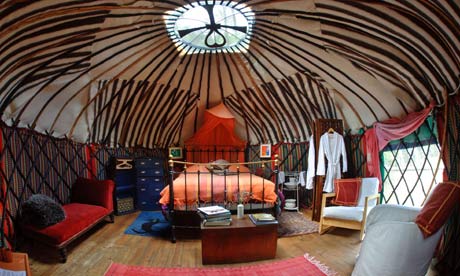
When a pound buys you little more than one euro, and staying at home was what you did last year, this summer's best holiday option may be to join the fastest growing trend – go glamping.
Backpack-free and not a soggy sleeping bag in sight, upmarket camping is coming of age in Britain with an explosion in the numbers of luxury venues for those who would like to enjoy the great outdoors without having to get their feet wet on a traditional campsite.
This month two specialist travel companies have opened dedicated glamping websites and Lonely Planet, the travel publisher, last month listed a glamping site as one of Britain's best short breaks.
This summer there will be more than 150 glamping sites around the country offering luxury accommodation with a outdoorsy feel. From a renovated shepherd's hut at the bottom of a field to a large bell tent in the garden of a B&B, the trend may help many in the tourist trade through what otherwise might be a tough economic season. Several upmarket hotels have joined the craze and are offering a five-star twist to the traditional holiday under canvas, with treehouses, tepees and yurts set up on their manicured lawns.
Glamping has been growing in popularity over the past two to three years, says Garri Rayner, who created goglamping.net in 2007 to cater for a niche market, but now works full time on the site. "This year the popularity of glamping is quite extraordinary," he said. "It's grown up with the popularity of festivals really, and you just need to see how many of them there are in Britain now.
"Camping doesn't appeal to most people. Sometimes you will get families really split, with one half liking it and the other not. But now, with so many options popping up all the time, and everyone even more eco-friendly, it's a great alternative.
"In terms of a family holiday for children, what's better than a secluded countryside spot with all the comforts of home?
"To date it has been seen as quite extravagant, with a lot of expensive places, but that's really changed this year. It can be low-cost, and there is something for everyone from every walk of life. But I'd say that it's the festival-goers who really have pushed the trend."
It's not hard to see how images of the muddy camping fields of Glastonbury may have put many people off a traditional tent holiday.
The festival's elite Camp Kerala – described by Vogue magazine as "unquestionably one of the most glamorous places to be in the UK" – has been growing in popularity over the past few years, albeit only among those who can afford the £8,000 price for a weekend in a shikar tent, originally designed for use by the maharajah of Jodhpur and filled with Rajasthani furnishings and duck-down duvets.
At the Latitude festival in Suffolk last weekend, organisers expanded the luxury campsite to include a number of 5m-wide bell tents, fully furnished and carpeted, complete with flowers and chocolates on the linen pillows and a lockable canvas door.
Jollydays, a luxury camping site in Yorkshire, is this year offering in-tent showers. For the camping purist it may be a cop-out, but the trend is spawning a new breed of enthusiasts, says Eliot O'Connor who runs a business with his wife from their premises in Oxford, importing traditionally-crafted yurts from Inner Mongolia.
"Its our sixth year in business and proving to be absolutely our best," he said. "We are getting all sorts of inquiries; farmers who are trying it out, putting up one in a field and seeing how it goes, then coming back for another three.
"Campsites are finding them really popular and are coming back for more. We're getting schools and even individuals who just want them in the garden for the kids, people from all walks of life. Some people are even living in them full time.
"They are very effective holiday homes. They are beautifully made, with willow frames and trellis that will last a lifetime. It's sad really that in Mongolia the use of them is fading fast, and it's only tourism that is keeping the craft going. So great news that everyone wants to stay in one here."

